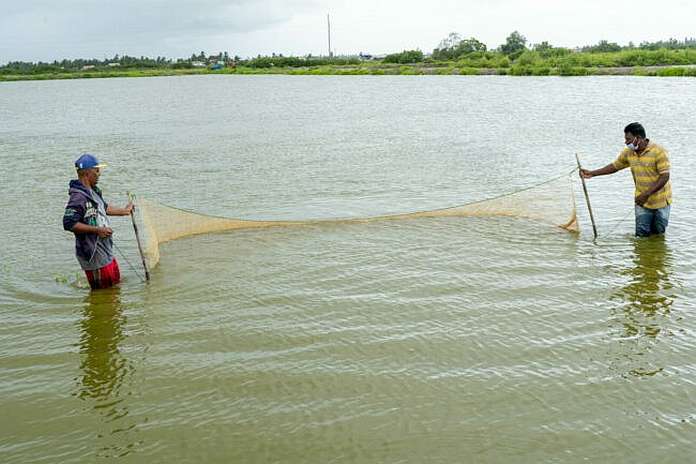By Kellon Rover
GEORGETOWN, Guyana, (DPI) – Brackish water shrimp production is growing by leaps and bounds along the Corentyne Coast, as the People’s Progressive Party/Civic (PPP/C) government continues to make a heavy investment to produce some 1.2 million kilograms of shrimps annually.
The government started the pilot project in July 2021, with 75 interested farmers in the ancient county. The intention was to ensure the income of shrimp farmers there is sustained, due to the impact on the local fisheries industry by the worldwide issue of low fish catches.
At the beginning, the farmers were producing just about 10,000 kilograms of shrimp monthly. June 2022 has proven to be a massive success, with a production of 70,000 kilograms of shrimps.
Minister of agriculture, Zulfikar Mustapha said he is optimistic that the industry will improve greatly.
“We have completed just around 75 percent of the project. So, by the time we would have completed the entire project, to develop all the shrimp farms across the region, I am expecting that annually, we might project like 1.2 million kilograms of brackish water shrimp,” the minister contended, during an interview with DPI on Wednesday.
He said the flagship initiative is another aggressive move by the administration to increase food production, thereby reducing Caricom’s food import bill by 25 percent by 2025.
“When you look at what we (government) are doing, this is one aspect of increasing food production in our country. The brackish water shrimp, a few months ago, was just 10,000 kilograms… and we have moved that within six months…and you can see the increase, more than seven times the amount,” the minister added.
“We have seen a number of persons now working in the industry. These regional farmers who had these farms, and we developed it, they now want more workers. This is the kind of way how the benefit is extending to the rural population in those communities.”
Meanwhile, the National Drainage and Irrigation Authority (NDIA) continues to play a major role in the different phases of the project.
“We used NDIA excavators to increase the size of the ponds. We will be doing civil works, like putting small boxes and tubes so they can have better drainage facility, and what our technical persons have been doing, working with them to ensure they mix the water in a way, so it can be conducive to shrimp farming,” he continued.
Minister Mustapha also explained that he wants the Berbice project to attain the highest success, before it is replicated in other parts of the country.
Since taking office on August 2, 2020, the administration has been paying significant attention to the nation’s fisheries sector, to ensure the livelihood of fisherfolk is maintained.
Apart from the shrimp production, several strategies were implemented to put more money into the rural economy. Investments are also being made in the aquaculture sector to enhance its position, not only in marine fishing, but to help acquire new paths within the visibly burgeoning food industry.
For instance, the ministry is looking to establish about 30 to 60 shade houses for the Three-Door fishermen’s Co-op at Rosignol, West Coast Berbice, to supplement their income.
Accordingly, minister Mustapha reiterated that government will soon begin distributing the $150,000 relief grants which was recently announced by the president to all fisherfolk.





